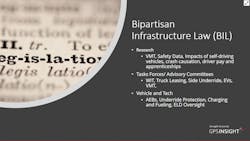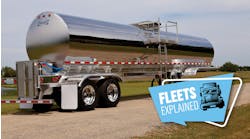The new year—barely a month old—already promises action on a host of regulatory and legislative issues, with speed limiters, newly published final emissions restrictions, and truck parking among the most prominent of these concerns. Also look for possible movement on several other notables such as the vehicle miles traveled (VMT) tax, driver detention reforms, the under-21 driver program, and a lot of follow-through on the Biden administration infrastructure law, a transportation expert predicts.
A Jan. 26 FleetOwner-hosted webinar, sponsored by fleet management and field services company GPS Insight, served as a forum for 2023 predictions from P. Sean Garney, co-director of Scopelitis Transportation Consulting.
See also: Divided Congress opens door for executive branch agenda
Garney wasn't short on insights for those who tuned into the hourlong presentation. GPS Insight’s VP of marketing, Belinda Rueffer, was the program’s moderator.
Speed limiters is a “big, sexy issue,” Garney said.
In a first proposed and highly controversial rulemaking, which received 15,666 Federal Register comments in response last summer, the Federal Motor Carrier Safety Administration called on all Classes 7-8 commercial vehicles to be limited to an as-yet-determined top speed. A second proposed rulemaking from FMCSA this year is expected to set that top speed, which some have suggested could be 65 miles per hour based on prior proposals out of Congress.
Allies of larger trucking companies such as the Truckload Carriers Association have come out mostly in favor of the speed-limiter proposal while others, including the Owner-Operator Independent Drivers Association, which represents small-operation truckers, have stood opposed to onboard speed governors.
Lively year in Congress, executive branch
Garney split his “look-ahead” on legislative and regulatory affairs into actions in Congress and those up to the executive branch and the Biden administration for movement.
The trucking industry has expected the logjam to break for years on a vehicle miles traveled tax, also known as a VMT and which is viewed as a fairer and more substantial way to fund the federal Highway Trust Fund than current taxes on diesel fuel and gasoline. Until the Infrastructure Investment and Jobs Act started pumping billions into road and bridge improvements nationwide, the VMT was seen as a more hot-button and urgent issue for the future of U.S. infrastructure.
See also: A primer on trucking issues from an industry heavyweight
“There had been writing on the wall for more than 10 years that our receipts [from traditional fuel taxes] were not keeping up with our obligations,” Garney observed, noting that the new infrastructure law includes a VMT a “research” component. “Congress has decided to conduct another study. A farther-reaching study will develop in the next few years.”
He added that a VMT is a less efficient way to track usage of the nation’s highway system, but that “a lot of people have been looking at it.” Other trucking advocates, such as American Trucking Associations (ATA), push for increasing existing diesel and gasoline taxes rather than phasing in an all-new funding mechanism, “but there is a negative view of raising taxes on people.” Federal fuel taxes on diesel and gas have not been raised since 1993.
Other studies, Garney said, might include the potential impact of self-driving vehicles, and Congress has asked FMCSA to redo its Large Truck Crash Causation Study, which was last updated in 2019, in the wake of a 13% increase in 2021 in roadway fatalities involving at least one large truck.
More but no less important issues in certain corners of the trucking industry were on the plate of the consultant, who is a former truck driver, dockworker, load scheduler, and freight broker.
See also: Bipartisan Senate bill would fund expanded truck parking
Also “in the hopper,” Garney said, is a Senate bill, the Truck Parking Safety Improvement Act, introduced late last year by one Republican and one Democrat, to provide $755 million in competitive grant funding to expand commercial truck parking capacity throughout the U.S. A companion House bill was passed in committee last July, but that bill has been sidelined because of the change in the power structure in the lower chamber of Congress.
ATA favors the Senate version, the trucking federation's leader said in a statement in December. “A chronic, nationwide shortage of commercial truck parking continues to strain our supply chain and jeopardize highway safety for all motorists,” ATA President and CEO Chris Spear said at the time. “This carefully crafted legislation provides needed investments to remedy the problem while incentivizing public-private partnerships to further expand truck parking capacity."
“I think we’ll see action this year on truck parking,” Garney predicted.
The webinar discussion also turned at one point to the federal Drug & Alcohol Clearinghouse, which has registered over 3 million CDL- and CLP-holders since its inception more than three years ago and where almost 178,000 positive drug tests for all substances (mostly for marijuana) have been reported. Almost 121,000 of those drivers still sit in prohibited status with the clearinghouse, meaning they can’t drive until they clear a return-to-duty process of counseling and testing.
Clearinghouse reporting protocols look to be streamlined in 2023—and more focus will fall this year on the status of hair-follicle testing as an accepted screening method, Garney said.
See also: Opinion: Why not hair testing?
Whether the results of hair testing, which many trucking companies use during driver pre-screening procedures with clearinghouse-sanctioned urinalysis, becomes accepted by the federal clearinghouse as well is still an open question in 2023, he said. But the agencies that oversee the decision will not be the U.S. Department of Transportation or FMCSA. The U.S. Department of Health and Human Services (DHHS) has that call, he said, and DOT would then follow with a rule that pertains to trucking and transportation.
Garney said: “A final rule [from DHHS] was predicted in December, but that has obviously been pushed.”






